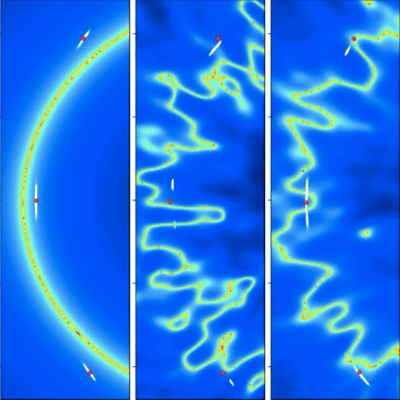|
Research Tasks
|
 |
Task 1 (before JWST): “Flashlights”
Detect time-variable point sources such as individual-magnified stars at high redshift, with the opportunity of the HST “Flashlights” program. Definitive constraints on the level of any PBH contribution to the DM will be generated. We will also create refined smooth WIMP lens models for the galaxy clusters in which Flashlight transients are detected, to which we will add an appropriate spectrum of granulations to approximate the behavior of FDM. We will then compare the observed properties of the transients to those predicted by the WIMP and the FDM lens models to see which DM model better agrees with the observations.
|
|
Task 2 (before JWST): FDM Simulations
Establish predictions for JWST to be best able to distinguish the WIMP paradigm from its alternative of fuzzy DM, by simulating the lensing effects of FDM (including those for individual-lensed stars) and the filaments at high redshift in the FDM context. To achieve this goal, we will in these simulations include astrophysical effects such as gas hydrodynamics and cooling, model the deflection field which will distort the JWST lensing observations and must be subtracted off, and examine a range of FDM mass and galaxy mass in the competing contexts.
|
 |
|
 |
Task 3 (JWST Time): Data Mining
Set up the JWST survey program and conduct data mining within the range of this proposal. Once the first JWST data arrives, we will apply it to (1) constraining the proportion of DM in the form of PBHs; (2) detecting magnification perturbations around Einstein rings of galaxy-scale lens and monitoring positional offset of individual-lensed stars.
|
|
Task 4: Interplaying with Theory
Explore observational phenomenology of DM at JWST throughout the course of CRF and take theoretical interpretation, evaluation and development, with the results of HST/JWST data mining. We will determine which paradigm is favored by HST/JWST data between the WIMP and fuzzy DM, and explore the underlying theory predicting the data-favored DM paradigm. If none of the existing DM paradigms are strongly favored by data, we will develop new ideas for next-step DM study.
|
 |
|
